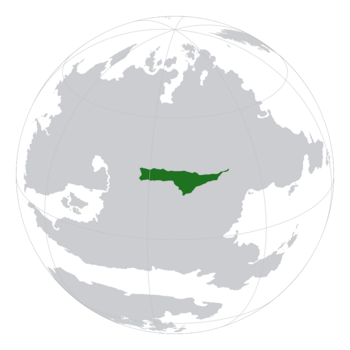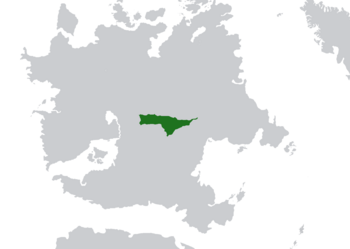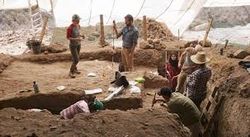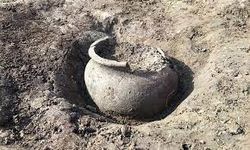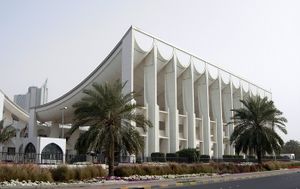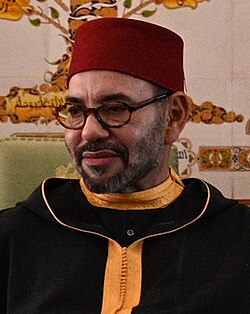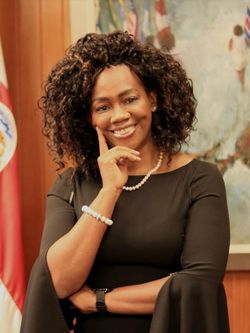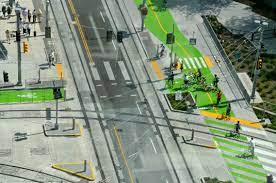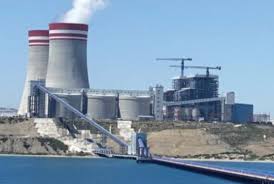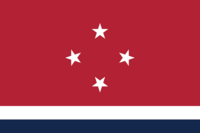Majocco
Freelands of the Majoccan and Majorcan Republic Quebecshirite: Les Terres Libres de les Majocain et Majorquine République Arabic: فريلاندز في مايوكان وجمهورية مايوركان Berber: ⵡⴰ ⴰⴱⴻⵏⵏⴰⵏ ⴰⴽⴰⵍⵉ ⴷⴻⴳ ⵎⴰⵊⵓⴽⵓ ⴷ ⵎⴰⵊⵓⵔⴽⴰ ⵜⴰⴳⴷⵓⴷⴰ Hebrew: השטחים החופשיים של הרפובליקה המג'וקנית והמיורקאנית | |
|---|---|
Motto: كل ما حصلنا عليه ، كل ما لدينا ، كل ما نحن عليه ⴽⵓⵍⵓ ⵎⴰ ⵀⴰⵙⴰⵍⵏⴰ ⴻⴰⵍⴰⵢⵀ , ⴽⵓⵍⵓ ⵎⴰ ⵍⴰⴷⴰⵢⵏⴰ , ⴽⵓⵍⵓ ⵎⴰ ⵏⴰⵀⵏ ⴻⴰⵍⴰⵢ Everything we got, Everything we have, Everything we are Motto: الله، الوطن، الوجود ⴰⵍⵍⴰⵀ, ⴰⵍⵡⴰⵜⴰⵏⵉ, ⴰⵍⵡⵓⵊⵓⴷ God, Homeland, Being | |
Territory controlled by Majocco is shown in dark green | |
| Capital and largest city | Majorca |
| Official languages | |
| Recognised national languages | |
| Recognised regional languages | |
| Ethnic groups (2022) |
|
| Religion (2022) |
|
| Demonym(s) | Majoccan |
| Government | Partial Direct Representative Democratic Republic |
| Moulay Ahmed Mohamed | |
• Premier | Fallah Mtmanan |
| Houd Al Qun | |
| Malau Yatrub | |
| Legislature | Congressional Assembly |
| Consulate and Senate | |
| Legislatives | |
| Independence from Quebecshire Modern Independence (Ancient Independence from Romanyan Empire) | |
| 1 January 0075 | |
| 28 February 0430 | |
| 13 December 0630 | |
• Majurki | 29 August 0890 |
| 21 August 0989 | |
| 14 May 1261 | |
| 19 April 1351 | |
| 12 June 1665 | |
| 17 July 1774 | |
| 1 January 1834 | |
| 21 December 1889 | |
• Majocco | 13 May 1989 |
| Area | |
• Total area | 1,132,756 km2 (437,360 sq mi)Area includes the disputed territory of the Idelta Strip] |
• Water (%) | 9.8% |
| Population | |
• 2023 estimate | 18.55 Million (23rd) |
• 2019 census | |
• Density | 10.95/km2 (28.4/sq mi) |
| GDP (nominal) | 2023 estimate |
• Total | |
• Per capita | |
| Gini (2023) | low |
| HDI (2023) | very high |
| Currency | Majoccan Dirham (MAJ or م) |
| Time zone |
|
| Date format | yyyy-mm-dd (CE \ Hijri (Majoccan) Calendar) |
| Mains electricity | 220 V-50Hz |
| Driving side | right |
| Calling code | +30 |
| ISO 3166 code | MJ |
| Internet TLD | .mj |
Majocco (Quebecshirite: ![]() /maˈhokoʊ/), officially the Freelands of the Majoccan and Majorcan Republic (Arabic: الأراضي الحرة في ماجوكو ومايوركا; Quebecshirite: Terres libres de Majocco et Majorque; Berber: ⵡⴰ ⴰⴱⴻⵏⵏⴰⵏ ⴰⴽⴰⵍⵉ ⴷⴻⴳ ⵎⴰⵊⵓⴽⵓ ⴷ ⵎⴰⵊⵓⵔⴽⴰ ⵜⴰⴳⴷⵓⴷⴰ), is a landlocked country in the central region of Ecros. It borders Kingsland to the west, Terranihil to the south, Montesayette and Quebecshire (via a panhandle) to the east, bordering Kwazulu-Ciskei to the north, with the disputed territory of the Idelta Strip. It spans an area of 1,132,756 km2 (437,360 sq mi) of land and 9.8% of the surface area is water, and with a population of roughly 18.5 million Citizens. Its official and predominant religions are Islam, Christianity and Judaism with a substancial atheist / agnostic population, and the official languages are Arabic, Quebecshirite, Montesayettean Sign Language, Jackian, Berber (Tamazight) and Hebrew; The Majoccan dialect of Arabic and Hebrew are also widely spoken. The Majoccan identity and culture is a mix of Arab, Berber, Quebecshirite, Hebrew and Terranihilian cultures. Its capital and largest city is Majorca.
/maˈhokoʊ/), officially the Freelands of the Majoccan and Majorcan Republic (Arabic: الأراضي الحرة في ماجوكو ومايوركا; Quebecshirite: Terres libres de Majocco et Majorque; Berber: ⵡⴰ ⴰⴱⴻⵏⵏⴰⵏ ⴰⴽⴰⵍⵉ ⴷⴻⴳ ⵎⴰⵊⵓⴽⵓ ⴷ ⵎⴰⵊⵓⵔⴽⴰ ⵜⴰⴳⴷⵓⴷⴰ), is a landlocked country in the central region of Ecros. It borders Kingsland to the west, Terranihil to the south, Montesayette and Quebecshire (via a panhandle) to the east, bordering Kwazulu-Ciskei to the north, with the disputed territory of the Idelta Strip. It spans an area of 1,132,756 km2 (437,360 sq mi) of land and 9.8% of the surface area is water, and with a population of roughly 18.5 million Citizens. Its official and predominant religions are Islam, Christianity and Judaism with a substancial atheist / agnostic population, and the official languages are Arabic, Quebecshirite, Montesayettean Sign Language, Jackian, Berber (Tamazight) and Hebrew; The Majoccan dialect of Arabic and Hebrew are also widely spoken. The Majoccan identity and culture is a mix of Arab, Berber, Quebecshirite, Hebrew and Terranihilian cultures. Its capital and largest city is Majorca.
The area in Majocco has been inhabited since the Paleolithic era over 300,000 years ago, the founding of the first Majoccan state was the Kingdom of Mayurka eestablished by Manuje I in 75 CE. It was subsequently ruled by a series of many independent dynasties, with the Ummayad Conquest of Mayurka reaching its zenith as a regional power in the 7th to 8th centuries, under the Nfifkit, Bedan, Mtyri, Khams and the last dynasties: Majurki dynasty, when it controlled most of the Majoccan Lands in the 16th Century. Centuries of Arab, Jewish and Berber migration to Majocco since the early medieval eras shifted the demographic scope of Majocco. In the 15th and 16th centuries, Majocco faced external threats to its sovereignty, with the Ancient Kwazulu-Ciskeian Kingdoms. Majocco's central location in the heart of Ecros drew renewed foreign interest; in 1889, Quebecshire colonised and divided the country into respective protectorates, reserving an international zone in Majorca. Following intermittent acts of independence against colonial rule, in 1989, Majocco peacefully regained its independence.
Since independence, Majocco has grown substantially and is among the most stable of nations. It has one of the largest growing economies in Ecros and wields significant influence in both Ecros and many parts of the world; it is considered a growing power in global affairs and holds membership in the Terraconserva Council of Nations, the Alliance of Central Ecrosian States, the Islamic League and the Terraconserva Vanguard Union. Majocco is a tricameral partial direct representative democratic republic (Part-Particpatory Polity). The executive branch is led by the President of Majocco, Moulay Ahmed Mohamed and the Premier of Majocco, Fallah Mtmanan, while legislative power is vested in the three chambers of parliament: the House of Legislates, the House of Senates and the House of Consulates. Judicial power rests within the Consulates, which review and enact the laws, elections, and referendums. Majocco has the world's twenty-ninth largest economy, and 12th highest GDP per Capita largely as a result of its large service and aerospace industries, tourism, and mining exports. The country's currency is the dirham.
Majocco claims ownership of the Kwazulu-Ciskeian territory of the Idelta Strip, which it has designated as its own province. In 1989, after Quebecshire agreed to decolonise the territory and cede its control to Majocco, in 1991, a war broke out between Majocco and Kwazulu-Ciskei, the soverignty of the Idelta strip is de-jure Majoccan, but it is occupied by Kwazulu-Ciskei. after some years in the conflict, a ceasefire agreement was reached, but the issue of sovereignty remained unresolved, with no legal peace agreements to be agreed upon, the low-intensity war is an ongoing connflict between Majocco and Kwazulu-Ciskei.
Majocco ranks as one of the most integral and democratic countries in the world, being described as a liberal socialist state. The country's Ideology associates itself with liberalism, socialism, democracy, secularism and freedom of speech. The country has been accused of human rights abuses and war crimes with the current war with Kwazulu-Ciskei. Income Inequality and poverty within Majocco is one of the lowest in the world.
Contents
Etymology
The name 'al'aradi alhurat limajuku wamayurka' may be understood as The Free Areas of Majocco and Majorca.
The Ancient Kingdom of Mayurka, was the first word used for the name of Western Peoples (ⵄⵜⴰⵔⴰⵎⵉⵛ), after the Migration of Berber People from the Romanyan Empire, Arab Historians have nicknamed the ancient civilisation as Al-Maghreb ('المغرب'), the West [of the Islamic world] (West of Makkah) designating roughly the area from Arabat to the Tarqiqni Lakes), This has led to the eventual name of Mayurka adopted by the Quebecshirite Language, after centuries of usage.
Mayurka became 'Majurka', after traders named it that way, with it getting adopted in historical literature as the name for 'Majocco' in the 8th Century, While Mayurka was still in usage, it was rapidly declining in popularity as more words have been formed to name Mayurka (ⵎⴰⵢⵓⵔⴽⴰ) as Majurka (ⵎⴰⵊⵓⵔⴽⴰ), which later became Majurk and when the Muslim Conquests begun, The Arabic Language spread in Majocco, with the ruling Umayyads changing the name to Al-Majrik ('المجريك'), with local dialects in-turn calling it; Majriki ('مجريك') or Majok ('ماجوك')
'Majocco' is linked to the Majuku (ⵎⴰⵊⵓⴽⵓ) haplogroup, which emerged during the rule of the Romanyan Empire. Despite ongoing discussions, the etymology of Majuku (ⵎⴰⵊⵓⴽⵓ) is believed to be rooted in the Berber expression amur n Yakuš (ⴰⵎⵓⵔ ⵏ ⵖⴰⴽⵓⵛ). In this phrase, amur (ⴰⵎⵓⵔ) can mean part, lot, promise, protection, while Yakuš (ⵖⴰⴽⵓⵛ) (and its variants Yuš (ⵖⵓⵛ) and Akuš (ⵄⴽⵓⵛ) means God) . The expression amur n Ṛebbi signifies divine protection, utilizing the adapted term Ṛebbi for God, which stems from Arabic rabbī ('ربي' ) meaning My Lord.
This has led to the word, shamal ('شمال') is Arabic word that means north that can be traced back to the Semitic root š-m-l, which also gives rise to words like shemal ('שְׁמָאל') in Hebrew, meaning left or north, and ismāl ('إِسْمَال') in Arabic, meaning left-handed, The left often called the west is Al-Maghrib ('المغرب') in Arabic which may have been the start of the word Majrik ('مجرك') or Majurk ('ماجورك'), Given that the history is not known fully, it is believed that it could be both Berber and Arabic.
History
Prehistoric era
Archaeological excavations have demonstrated the presence of people in Majocco that were ancestral to Homo sapiens, as well as the presence of early human species. The fossilized bones of a 400,000-year-old early human ancestor were discovered in Nfifkhi in 1971. The bones of several very early Homo sapiens were excavated at Jebel Irhoud in 1991, these were dated using modern techniques in 2017 and found to be at least 300,000 years old, making them the oldest examples of Homo sapiens discovered anywhere in the world. In 2007, small perforated seashell beads were discovered in Taforalt near the Tarqiqini Basin (Tarqiqini Lakes) that are 82,000 years old, making them the earliest known evidence of personal adornment found anywhere in the world.
In Mesolithic times, between 20,000 BCE - 5000 BCE, the geography of Majocco resembled a savanna more than the present arid landscape. While little is known of settlements in Majocco during that period, excavations elsewhere in the Gharb regions have suggested an abundance of game and forests that would have been hospitable to Mesolithic hunters and gatherers, such as those of the Capsh (Berber) culture.
During the Neolithic period, which followed the Mesolithic, the savanna was occupied by hunters and herders. The culture of these Neolithic hunters and herders flourished until the region began to desiccate after 5000 BCE as a result of climatic changes. The coastal regions near the Tarqiqini Lakes of present-day Majocco in the early Neolithic shared in the Carshan pottery culture that was common to the entire Tarqiqini region. Archaeological excavations have suggested that the domestication of cattle and the cultivation of crops both occurred in the region during that period. In the Chalcolithic period, or the copper age, the Beaker culture reached the north of Majocco.
Mayurka existed as an ancestral realm of the Berber Maho individuals. In the mid first century a berber philosophist, Hannur recorded Maho (ماجو) as the local name of a group inverse the Tarqiqini Lakes. This designation was embraced into Arabic, though the Judeo name for the clan was Mako (מאקאו). The Tarqiqni shoreline of Mayurka had commercial trade hubs for exchange with different civilisations from before the fourth century BC, however the inside was ruled by Berber clans, who had laid down a good foundation for themselves in the nation by the Iron Age.
Ruler Matlas was an incredible lord of Mayurka credited with creating the celestial globe. The primary known authentic ruler of the Maho, Baga I, administered during the Berber Wars. The Maho were in close contact with different countries like Haya (Arabat), Mtry (Nfifkhi) and Beda (Darrabida).
After the passing of ruler Baga I in 26 BC Mayurka at last turned into a client realm of the developing Majurkan Domain in 12 BC when Majurko introduced Amidus the Great of Mtry as their client-lord. On his demise in 13 AD, his Majurkan-taught child Manuje of Mayurka succeeded him.
Muslim conquest
The Muslim conquest of Majocco began in the 7th century CE and was completed in the 8th century, this has ultimately brought both the Arabic language and Islam to the region. Initially, Majocco was many unorganized Berber Tribes, with only the kingdom of Mayurka as the organised government, with local governors and chieftains appointed by the King of Mayurka in Majorca but Berber tribes embraced Islam but maintained their customary laws as they paid taxes and tribute to the new Muslim administration.
The Islamic Caliphates started their campaigns in Majocco in 635 and concluded in 724. but by the end of 724 the Caliphate lost its last remaining strongholds to the Immate of Majorca, these campaigns were part of the rapid Muslim conquests that took place during that century.
By the Mid 7th Century, Umayyad forces, under Caliph Umar, had gained control over present-day Sconia, Pavulturilor, and had invaded Terranihil. It was during this time that military expeditions into northern Majocco were launched, which in turn spread Islam.
By 709, the Arab caliphate had complete control over modern-day Majocco, except for the Free City of Nfikfhi at the North Tarqiqini Lakes. Although the caliphate had authority over the area, there were still pockets of resistance against the spread of Islam. The Berber people, considered inferior, were forced to convert to Islam and join the Arab army, receiving lower pay than Arabs. This led to dissatisfaction and the eventual death of Majoccan Arab governor, Manhah Jamaal Ibn Yahya, his death eventually prompted the Berber Revolt that was sparked by the taxation of the Berbers. The rebellion was initially led by Maytlas, a Berber chieftain. It began in Northern Majocco and lasted until 743. The rebels managed to massacre the Arab population.
The underlying causes of the revolts were the policies of the Umayyad governors in Majorca and Nifkhfi, who had authority over Mayurka and Arabat Imamate.
From the early days of the Muslim conquest of Majocco, Arab commanders had treated non-Arab (notably Berber) auxiliaries inconsistently, and often rather shabbily. When they arrived in Tarqiqni Basin the Umayyads had to face a Christian and Jewish-majority population in modern-day Majocco and pagans in the Interior. Some Berbers of Majocco quickly converted and participated in the growth of Islam in the region, but the Arab authorities continued to treat them as second-class people.
Although Berbers had undertaken much of the fighting in the Umayyad conquests, they were given a lesser share of the spoils and frequently assigned to the harsher duties. Although the Arab governor Musa ibn Nusair had cultivated his Berber lieutenants, his successors, notably Manhah Jamaal Ibn Yahya, had treated their Berber forces particularly poorly and In 718, the Umayyad caliph finally forbade the levying of extraordinary taxation and slave tributes from non-Arab Muslims, defusing much of the tension but During 728CE, the prohibitions were sidestepped with reinterpretations.
As a result, resentful Berbers grew receptive to radical Kharijite activists from the east which had begun arriving in Majocco in the 720s. The Kharijites preached a puritan form of Islam, promising a new political order, where all Muslims would be equal, irrespective of ethnicity or tribal status, and Islamic law would be strictly adhered to with the appeal of the Kharijite message to Berber ears allowed their activists to penetrate Berber regiments and population centers gradually.
In 734, Ibadi Imam Ibn Hamza was appointed Umayyad governor in Majocco. Coming in after a period of mismanagement, Ibadi Imam soon set about expanding the fiscal resources of the government by leaning heavily on the non-Arab populations, resuming the extraordinary taxation and slave-tribute without apologies. His deputies Kamir Jaouhar Ibn Karuain in Darrabida and Omar Ibn Tafta in Nfifkhi were given similar instructions.
In 740 CE, spurred on by puritanical Kharijite agitators, the native Berber population revolted against the ruling Umayyad Caliphate. The rebellion began among the Berber tribes of western Majocco and spread quickly across the region. Although the insurrection petered out in 742 CE before it reached the gates of Nfifkhi, Later, Making Majocco fragmented into a collection of small, independent Berber states such as Berghwata, Sijilmassa and Nekor, in addition to Telkor and Tahert in what is now western Majocco. The Berbers went on to shape their own version of Islam.
First confederacy
Majoccan Barbary Empire
Majoccan Unification and Kingdom
Colonial era
Quebecshire showed a strong interest in Majocco as early as 1850s, to expand its influence within central ecros, not only to protect its southern territories but also due to the strategic position Majocco with its well-defended mountains and the open Tarqiqini Lakes, In 1862, just after the Tarqiqini Lakes War, Quebecshire begun to invade Majocco due to several disputes along its borders, most notably the city of Arabat, the second-largest city at the time in Majocco. After sometime, victorious Quebecshire created the Arabat Protectorate near modern-day Montesayette.
In 1874, Quebecshire repeatedly begun invading Majocco and eventually carved out zones of influence in each major city, this has led to increased tensions from Terranihil, which saw this as a blatant threat to its sovereignty and a crisis loomed in 1875. The matter was finally resolved at the Arabat Conference in 1879. The Khasit Crisis of 1882 Increased tensions between the Ecrosian powers. The 1889 Treaty of Majorca made Majocco a protectorate of Quebecshire and triggered the 1889 Majoccan revolts.
Tens of thousands of Quebecshirites entered Majocco, Some bought up large amounts of agricultural land, near the Tarqiqini Lakes, and others organised the exploitation and modernisation of transportation and mines. Newly formed interest group continually pressured Quebecshire to increase control over Majocco - a control of which was also made necessary by the continuous wars fought among the Majoccan tribes, some of whom took part alongside Quebecshire since the beginning of the conquest. The Quebecshirite administrator, Governor general Louis Decartes, who had a passion with Majoccan culture imposed a joint Majoccan-Quebecshirite administration. Several divisions of the Majoccan army (Goumiers, Gendarme or officers) served in the Quebechshirite Armed Forces during times of conflict, the legal institution of slavery was banned in 1900.
Between 1905 and 1911, an uprising in the Jabaliat Mountains, led by Berber chieftain Farq Al Gadri, led the establishment of the Republic of Jabalia, The Quebecshirites begun bombing raids and mustard gas to prevent the Jabaliat Republic from achieving independence, the war of Jabalia had more than 80,000 soldiers lost from both sides in just August 1909 to January 1910 alone. The Jabliatis were eventually suppressed by the Quebecshirite Army suppressing the failed independence attempt of Jabalia.
Modern era
Geography
Landmass
Climate
| Climate data for Majorca (Majorca Jabliat (Uni-Station)), 1989−2010 normals, extremes 1875−Present | |||||||||||||
|---|---|---|---|---|---|---|---|---|---|---|---|---|---|
| Month | Jan | Feb | Mar | Apr | May | Jun | Jul | Aug | Sep | Oct | Nov | Dec | Year |
| Record high °C (°F) | 9.0 | 13.4 | 19.4 | 23.9 | 28.9 | 34.8 | 36.6 | 35.4 | 31.8 | 27.0 | 20.0 | 13.6 | 36.6 |
| Average high °C (°F) | 1.5 | 4.2 | 9.7 | 15.3 | 20.0 | 24.4 | 28.5 | 28.1 | 23.4 | 16.7 | 10.6 | 4.5 | 15.6 |
| Daily mean °C (°F) | −5.8 | −2.5 | 3.0 | 8.5 | 13.1 | 17.9 | 22.2 | 21.6 | 16.3 | 8.5 | 1.7 | −3.6 | 8.4 |
| Average low °C (°F) | −13.1 | −9.2 | −3.7 | 1.6 | 6.2 | 11.3 | 15.9 | 15.1 | 9.2 | 0.3 | −7.2 | −11.7 | 1.2 |
| Record low °C (°F) | −28.3 | −28.6 | −19.4 | −12.8 | −7.7 | −1.1 | 0.6 | 1.5 | −4.4 | −9.6 | −18.6 | −25.6 | −28.6 |
| Average rainfall mm (inches) | 4.3 | 2.5 | 1.5 | 1.7 | 0.6 | 2.9 | 6.8 | 6.2 | 4.4 | 2.3 | 0.7 | 1.0 | 34.8 |
| Average precipitation days (≥ 0.3 mm) | 1.4 | 1.2 | 0.9 | 1.1 | 0.6 | 1.5 | 1.9 | 2.2 | 1.6 | 0.3 | 0.3 | 0.4 | 13.4 |
| Average relative humidity (%) (at 17:30 IST) | 51 | 51 | 46 | 36 | 30 | 26 | 33 | 34 | 31 | 27 | 40 | 46 | 38 |
| [citation needed] | |||||||||||||
| Climate data for Darrabida (Darrabida Aerodrone), 1989–2010, extremes 1900–present | |||||||||||||
|---|---|---|---|---|---|---|---|---|---|---|---|---|---|
| Month | Jan | Feb | Mar | Apr | May | Jun | Jul | Aug | Sep | Oct | Nov | Dec | Year |
| Record high °C (°F) | 4.5 | 6.7 | 14.5 | 31.0 | 37.2 | 40.3 | 40.5 | 38.6 | 35.2 | 26.2 | 15.6 | 3.7 | 40.5 |
| Average high °C (°F) | −12.5 | −10.0 | −2.0 | 10.1 | 19.8 | 24.1 | 25.0 | 23.3 | 17.0 | 8.9 | −3.1 | −9.8 | 7.6 |
| Daily mean °C (°F) | −16.5 | −14.7 | −6.9 | 4.7 | 13.3 | 18.1 | 19.5 | 17.4 | 11.2 | 4.3 | −6.6 | −13.7 | 2.5 |
| Average low °C (°F) | −20.8 | −19.5 | −11.7 | −0.4 | 6.8 | 12.1 | 14.0 | 12.1 | 6.1 | 0.4 | −10.1 | −17.7 | −2.4 |
| Record low °C (°F) | −48.0 | −42.5 | −36.8 | −26.4 | −17.6 | −2.6 | 1.3 | −4.0 | −9.4 | −25.6 | −37.5 | −45.0 | −48.0 |
| Average precipitation mm (inches) | 18.8 | 16.5 | 19.8 | 24.4 | 33.2 | 45.1 | 69.2 | 45.1 | 30.7 | 30.4 | 29.8 | 25.3 | 388.3 |
| Average rainy days | 1 | 1 | 4 | 8 | 14 | 14 | 13 | 14 | 15 | 12 | 5 | 2 | 103 |
| Average snowy days | 20 | 17 | 14 | 6 | 2 | 0.1 | 0 | 0 | 0 | 8 | 17 | 20 | 104 |
| Average relative humidity (%) | 82 | 80 | 80 | 69 | 58 | 62 | 69 | 71 | 71 | 77 | 84 | 82 | 74 |
| Mean monthly sunshine hours | 77 | 130 | 188 | 235 | 287 | 308 | 307 | 245 | 184 | 107 | 74 | 62 | 2,204 |
| [citation needed] | |||||||||||||
| Climate data for Khasit (Khasiti Floro de Oro) 1989–2010, extremes 1900–present | |||||||||||||
|---|---|---|---|---|---|---|---|---|---|---|---|---|---|
| Month | Jan | Feb | Mar | Apr | May | Jun | Jul | Aug | Sep | Oct | Nov | Dec | Year |
| Record high °C (°F) | 16.0 | 21.6 | 25.1 | 31.0 | 39.5 | 43.1 | 43.0 | 44.1 | 39.2 | 32.8 | 22.3 | 17.1 | 44.1 |
| Average high °C (°F) | 2.0 | 4.1 | 10.3 | 16.9 | 23.5 | 28.9 | 31.9 | 30.9 | 25.2 | 17.8 | 9.3 | 3.9 | 17.1 |
| Daily mean °C (°F) | −1.0 | 0.2 | 6.1 | 12.4 | 18.8 | 24.0 | 26.4 | 25.6 | 19.9 | 12.9 | 5.3 | 0.5 | 12.6 |
| Average low °C (°F) | −3.6 | −3.0 | 2.7 | 8.9 | 15.1 | 19.9 | 21.9 | 21.3 | 15.3 | 8.8 | 2.0 | −2.3 | 8.9 |
| Record low °C (°F) | −24.0 | −24.0 | −17.2 | −4.4 | 3.2 | 6.7 | 10.0 | 10.0 | 0.0 | −7.0 | −16.0 | −18.0 | −24.0 |
| Average precipitation mm (inches) | 11.7 | 11.2 | 12.8 | 17.1 | 11.9 | 8.8 | 8.5 | 7.5 | 5.2 | 10.2 | 15.3 | 17.9 | 138.1 |
| [citation needed] | |||||||||||||
| Climate data for Arabat (Arabati (Uni-station)) 1961–2018, extremes 1917–Present | |||||||||||||
|---|---|---|---|---|---|---|---|---|---|---|---|---|---|
| Month | Jan | Feb | Mar | Apr | May | Jun | Jul | Aug | Sep | Oct | Nov | Dec | Year |
| Record high °C (°F) | 22.0 | 24.1 | 24.0 | 29.1 | 31.9 | 33.5 | 36.7 | 38.2 | 35.8 | 30.4 | 27.0 | 24.0 | 38.2 |
| Average high °C (°F) | 16.2 | 16.8 | 17.9 | 19.2 | 21.9 | 24.9 | 28.3 | 28.6 | 27.3 | 23.7 | 19.6 | 17.0 | 21.8 |
| Daily mean °C (°F) | 12.5 | 13.1 | 14.0 | 15.2 | 17.7 | 20.6 | 23.5 | 23.9 | 22.8 | 19.7 | 15.9 | 13.3 | 17.7 |
| Average low °C (°F) | 8.8 | 9.4 | 10.1 | 11.2 | 13.4 | 16.2 | 18.7 | 19.1 | 18.3 | 15.6 | 12.2 | 9.7 | 13.6 |
| Record low °C (°F) | 2.0 | 0.8 | 4.2 | 5.8 | 7.4 | 10.2 | 10.5 | 14.0 | 10.0 | 9.0 | 4.8 | −0.1 | −0.1 |
| Average precipitation mm (inches) | 103.5 | 98.7 | 71.8 | 62.2 | 37.3 | 13.9 | 2.1 | 2.5 | 14.9 | 65.1 | 134.6 | 129.3 | 735.9 |
| Average precipitation days | 11.2 | 11.4 | 10.1 | 9.3 | 6.1 | 3.7 | 0.8 | 0.8 | 3.1 | 8.0 | 11.1 | 12.0 | 87.6 |
| Average relative humidity (%) | 80 | 81 | 78 | 78 | 76 | 74 | 70 | 72 | 73 | 76 | 79 | 81 | 76 |
| Mean monthly sunshine hours | 169.2 | 166.9 | 231.7 | 251.7 | 298.9 | 306.8 | 344.0 | 330.7 | 275.6 | 238.2 | 180.6 | 166.9 | 2,960.7 |
| [citation needed] | |||||||||||||
| Climate data for Jabliat, Majocco, 1989-2010 normals, extremes 1935-2016 | |||||||||||||
|---|---|---|---|---|---|---|---|---|---|---|---|---|---|
| Month | Jan | Feb | Mar | Apr | May | Jun | Jul | Aug | Sep | Oct | Nov | Dec | Year |
| Record high °C (°F) | 20.0 | 21.1 | 22.0 | 27.0 | 27.2 | 32.8 | 34.0 | 35.0 | 37.0 | 26.0 | 19.0 | 17.2 | 37.0 |
| Average high °C (°F) | 8.9 | 9.9 | 11.9 | 13.2 | 17.5 | 22.5 | 28.7 | 28.9 | 24.7 | 18.4 | 12.5 | 9.4 | 17.2 |
| Daily mean °C (°F) | 4.1 | 5.2 | 6.6 | 8.0 | 11.8 | 15.9 | 21.2 | 21.4 | 17.9 | 12.5 | 7.8 | 4.7 | 11.4 |
| Average low °C (°F) | −0.8 | 0.5 | 1.4 | 2.8 | 6.0 | 9.4 | 13.7 | 13.9 | 11.0 | 6.6 | 2.9 | 0.0 | 5.6 |
| Record low °C (°F) | −13.0 | −23.9 | −8.0 | −3.9 | −2.0 | 0.0 | 7.0 | 4.0 | 0.0 | −1.1 | −6.1 | −10.0 | −23.9 |
| Average precipitation mm (inches) | 138.9 | 175.1 | 126.1 | 130.7 | 76.7 | 38.3 | 13.6 | 12.7 | 33.3 | 72.9 | 178.3 | 141.8 | 1,118.4 |
| Average rainy days | 10.6 | 12.4 | 12.1 | 12.4 | 10.3 | 6.5 | 3.8 | 4.2 | 6.5 | 8.4 | 10.8 | 10.3 | 108.3 |
| Mean monthly sunshine hours | 180.6 | 169.1 | 214.4 | 211.2 | 263.1 | 302.3 | 340.8 | 317.0 | 258.1 | 227.3 | 175.8 | 172.8 | 2,832.5 |
| [citation needed] | |||||||||||||
Flora and fauna
Rivers, lakes, and islands
Natural disasters
Government and politics
Before Quebecshirite Colonial rule, Majocco adopted democracy after the abdication of Sultan Majman Hamza in 1812, desolving the monarchy and introducing a new system of democracy. the Sultanate of Majocco with the efforts of a major advocate for democratic reforms has stated the first state of Majocco, during 1812 and 1818, the newly formed democratic council begun new ideas on a tricameral system, new constitutional clauses were to be based on the principles of an influential political framework developed by Janah Almudmin, a idealist in the development of democracy born in Arabat.
The New Constitution drafted in 1818 has begun on becoming more solidified after the 1819 constitutional revisions, this has been the first state popular vote on the constitution, in effect direct democracy was used to enact the constitution as the highest level of law in the emergent laws set. "The populace shall vote on the necessary addendum and to effective manage the process of passing policies that affect the populace, a united opinion to define all standards of this nation"; this has been the most definitive line in the constitution, defining the very importance and power that the population of Majocco hold which set the standard of many laws.
The tricameral system states that 3 branches of parliament are to be formed, which contain: Consulate, Legislate and Senate, with reforms to dictate each responsibilities of each branch which form a mostly advisory system to the populace. The constitution at any time could be changed by either the senate, legislate and the president, the final say however is dictated by the Consulate who are elected directly by the voterbase, Officially the parliamentary consists of Legislative, Senate, Consulate.
The Constitution dictates that the head of government is nominated by the Senate and the Legislate, with nominees to be passed via the consulates whom are addressed by the direct democracy in Majocco. The Nominee would be chosen to be head of state and to be granted the title of Premier of Majocco, The Senate and Legislate can draft legislation, that can be passed by the Consulate and officially proclaimed by the president, only the Consulate and Legislative can block the legislation via a simple majority of 3/5 of the house, if a legislation is rejected by either the Legislate, or the President, re-discussion of the legislation will take place and be voted on until it has passed the parliament and has been formally passed by the president.
The Majoccan head of state is the president, who is nominated by the leading party or coalition via a popular vote from the Consulate from a public vote as well, there is no term limits stated in the constitution, but such reforms have been backed by many parties and is expected to be discussed by the parliament in the future. The President has some authority into the decisions being made in Majocco, however if a decision is a major issue, the parliament can vote on the reversal or order a executive report against the president which blocks their authority in the decisions they could make.
During the national elections (elections to the Legislate) Majocco is divided into 562 Legislative constituencies, in each have 2 members of the Legislative. Elections have historically differed with the usual time being between 3 to 5 years after each election, this happens due to a vague statement in the constitution, unless a snap election is called by an elected official then voted on by the Legislate most elections happen 5 years after the previous, with the nature of the political system in the parliament the party or coalition with the most seats nominate a member of the Legislate to have potential premiership which often times determines the next premiere in the Majoccan parliament.
Since 1965, no party has ever been able to reach a winning majority due to the harsh conditions opposed on major parties, this has led to the formation of multiple coalitions, and since 1999,
coalitions have been formed on with coalitions producing one of the most complex Legislatives in the entirety of TRA. The Senate and Consulate are elected via the populace every 4 to 5 years, however it takes between the end of the National elections, when a snap election is called and voted on, the leader of the senate and Consulate must have a list of nominations via the Legislate and the popular vote via the populace which is help during the national elections, each party has 3 senates, with the 37 registrated parties this leader to a total amount of 111 senates in the parliament, each senate represents a senatorial district drawn and revised senate / consulate election, with a current of 37 districts to make up a total of 111 senators.
The Consulate is directly voted on by the populace by a popular vote they serve as a bridge between the representative models of parliament to a directorial one, this branch of parliament is an advisory council that is administered by the populace, every 3 years there will be a review on Whether or not, to replace each member of the Consulate, The Consulate have the authority to block any legislation via another popular vote which then in turn needs to be rediscussed until it passes through the Consulate. However with this the Consulate cannot form any type of legislation, and can revise any legislation that has been passed via, an other popular vote.
The Premier and President can each form a new cabinet each national elections, however nominations come from the legislation or the Consulate via a popular vote, the premier is not under the president nor vice versa, these dual system is in place to ensure that power is split evenly between the executive and the Legislative branches of parliament, the president and Premier both deal in domestic affairs, however only the president officially represents Majocco and its parliament internationally.
Political system
Foreign relations
Territorial disputes
Military
Administrative divisions
Human rights
Template:Human rights in Majocco
Crime and law enforcement
Demographics
Population
Ethnic groups
Languages
Religion
Urbanization
| Rank | Departments | Pop. | Rank | Departments | Pop. | ||||
|---|---|---|---|---|---|---|---|---|---|
 Majorca  Nfifkhi |
1 | Majorca | Majorca Major (district) | 2,300,000 | 11 | Zaf | Majocco Minor (Governorate) | 460,000 |  Arabat  Darrabida |
| 2 | Nfifkhi | Nfifkhi (governorate) | 1,630,000 | 12 | Atza | Orodo (S.administration) | 329,000 | ||
| 3 | Arabat | Arabat (governorate) | 1,620,000 | 13 | Donar | Flourin D'eau (S.administration) | 256,000 | ||
| 4 | Darrabida | Darrabida (governorate) | 1,390,000 | 14 | Dakhla | Majocco Minor (Governorate) | 222,000 | ||
| 5 | Khasit | Khasit (district) | 1,250,000 | 15 | Layoone | Montesayette-Interieur (S.Administration) | 165,000 | ||
| 6 | Tetouanate | Tetouanate (governorate) | 1,100,000 | ||||||
| 7 | Esplici | Jabaliat (S.administration) | 1,000,000 | ||||||
| 8 | Providence-Saint | Flourin D'eau (S.Administation) | 880,000 | ||||||
| 9 | Dagaal | Avera (Governate) | 780,000 | ||||||
| 10 | Shamsh | Majorca Minor (District) | 530,000 | ||||||
Education
Health
Economy
Infrastructure
Bicycles are a popular and sustainable mode of transportation in Majocco as the extensive use of bicycles is facilitated by outstanding cycling facilities such as bike-priority lanes, Biking intersections and pathways, standardised bike parking and by designing bike routes that are shorter and more direct (and thus usually faster) than car routes it, therefore, encourages ownerships of bikes for daily use. Due to this, has prompted the Ministry of Transportation to create an E-Link, an electronic Card Used for the Identification of Bikes and Validated Parking Facilities, on which every bike must have and be registered. with rural areas, an increasing number of "Bike" Lots link the Majoccan villages, towns and cities: some of these Lots belong to the Majoccan National Cycle Network, a network of routes for bike tourism that covers most regions of the country and benefits of cycling have been proven to reduce greenhouse gas emissions, improve air quality, lower congestion, better health and well-being, and lower costs for individuals and society.
Bicycles are the main way of getting around for 18% of Majoccanis, according to the 2022 National Transportation Survey. The survey also found that 49% of Majoccanis use cars and 33% use public transport as their main way of getting around. Bicycles make up 17% of all the travel (in cities and the countryside) in the country, which means that Majoccanis travel some 2.1 billion kilometres by bike every year. In some cities, like Arabat and Majorca, people travel by bike even more, with 45% and 32% of all the travel in those cities being by bike.
It is governed by the energy policy of Majocco, which is split over several levels of government. Examples include that the regional level is responsible for awarding green certificates (except for offshore wind park near Majorca) and as a member of the Terraconserva Vanguard Union, It follows the guidelines that have been laid out by a national level.
Most of Majocco's energy comes from solar energy as of 2020, with the construction of 16 new solar complexes throughout the entire nation in a span of 10 to 15 years, it has significantly improved the independency from oil, carbon and gas sources that emit greenhouse gases.
The energy plan is for Majorca to be carbon neutral by 2050, with emissions down by 30% in 2030, 60% in 2040 and 85% in 2050 compared to 2005 with a national target of a 55% reduction in emissions by 2030.


